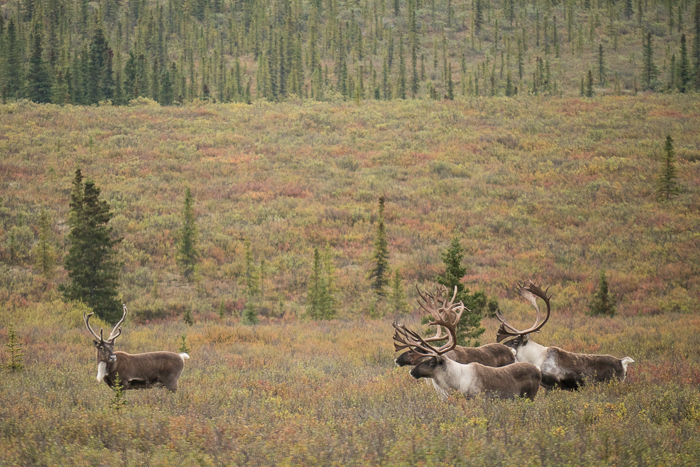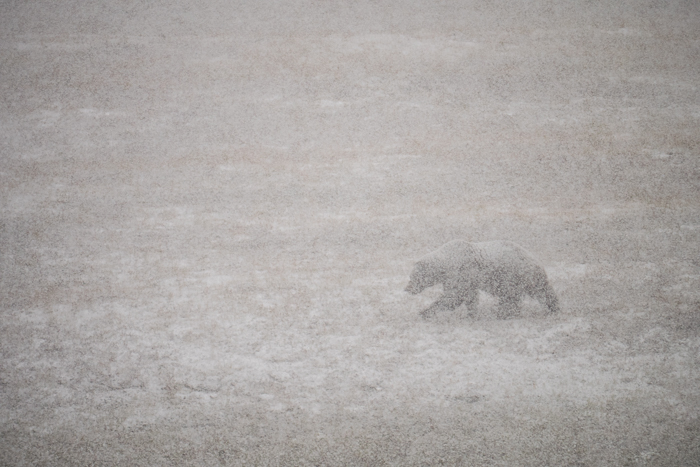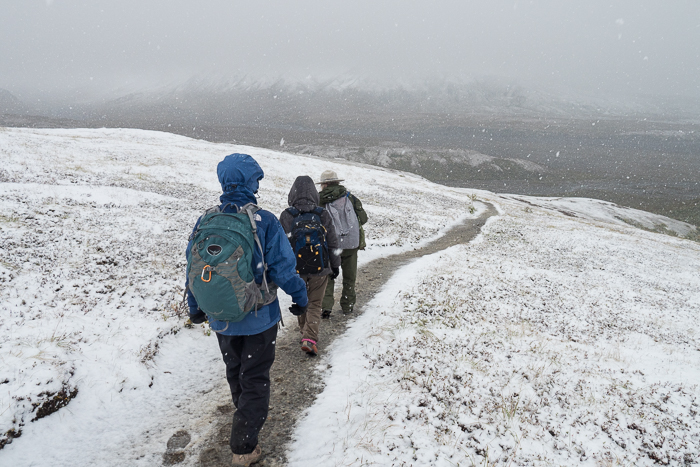Bonus poem: My Nice Dry Cabin.
We were bouncing down a dirt road in an old school bus, making the eight-hour round-trip journey from the Wilderness Access Center to the Eielson Visitor Center, 66 miles deep into Alaska’s Denali National Park. Only the first fifteen miles were paved; the rest of the trip was on a narrow gravel road.
Of Denali’s six million acres – six million! – there’s only one small dirt road snaking through it, minimizing human impact and intrusion on the land. Miles and miles of totally untouched wilderness stretched out on either side. The vast majority of people stay close to the park entrance, maybe traveling down those fifteen paved miles to the Savage River, the turnaround spot for private vehicles. Many people don’t even hike the few trails at the park entrance. A subset of people will, like us, go as far as Eielson. A much smaller subset will go all the way to Wonder Lake, 85 miles in, and either come back the same day (12-hours round-trip) or camp there.
And a few crazy folks will get off a bus somewhere along the way and hike up a nameless canyon, or down an unexplored creek, or over an indiscriminate ridge, and disappear for a while.
Tracy, our bus driver, was chatty and informative. She had the heater blasting, which was wonderful to the point of discomfort. It was a freezing cold, overcast day, so the heat felt good, but the heater was right at my feet. I was soon stripping off everything I could while remaining decent, and would later look back longingly at being so toasty warm.
Rattling down the gravel road, I admired the wide open landscape, red and green with fall color. We passed river valleys, the water fanning out in braids across the flood plains. I searched and searched for animals: for moose behind trees, for bears on the hillsides or in valleys, for Dall sheep high on the craggy rocks.
It wasn’t long before we saw some shapes and colors that didn’t quite match the surrounding landscape. The bus stopped; everyone peered out the windows. Suddenly there was movement, and the shapes became caribou, sporting white rumps and enormous curving antlers. How do they walk around with those huge things sitting on their heads? Those antlers would totally get snagged in a forest.
Which is why, I now understand, they live on open plains.

Soon after, a massive grizzly bear with big ole paws and huge shoulders came ambling down the road, completely unconcerned, passing right below our window. I wanted to climb out and give a true bear hug, but Martin held me back.
Although I’m happy to report that I eventually did get to hug a bear.

A big ole huggable Grizzly Bear 
The only bear Martin let me hug
At one nondescript curve in the road, deep in the backcountry, two passengers asked to be let off the bus. We all watched, dumbfounded, as they expertly hefted full backpacks, clambered down the steps, and strode confidently off into the endless expanse of park. They didn’t seem concerned with the dark skies overhead.
Not much further on, I looked up at a craggy peak and didn’t even have to use my binoculars, I just knew. The brown rocks had seven very distinct, very white, very round blobs up there. No way was that snow. A few curves later brought us to a turnout where we could get out and see the Dall sheep with their beautiful curved horns, picking their way across the craggy rocks.
Loving this bus ride!
It was right about then that it started to snow.
Pretty little snowflakes drifted softly past the windows. A few passengers expressed concern – it’s snowing! We’re way in the backcountry! – but Tracy chuckled. “We know a thing or two about snow here in Alaska! I drive a school bus all winter! A little snow ain’t nothing! A lot of snow ain’t nothing!”
And we rumbled on towards Eielson.

The snow started truly coming down, spilling from the sky, practically blotting out the landscape. Not enough to blot out another grizzly bear sighting, though. We saw him through the flurries, the ground white, the background white, his fur white. He shuffled through that white world, exploring holes – looking for arctic squirrels? – sniffing here and there, seemingly unconcerned with the snow pouring down around him.
Yep, just another summer day in Alaska!
We pulled into the Eielson Visitor Center parking lot at noon and scuttled inside. Tracy was giving us half an hour for lunch and would then be returning to the park entrance. Anyone who wanted to go with her could do so; anyone who wanted to stay could return on the “next available” bus.
That was the catch phrase, right there. The “next available” bus. Martin and I had already told Tracy we wouldn’t be on her bus. We’d simply catch another one.
Like it would be really easy.
We wandered through the Visitor Center, getting a chuckle at the enormous bay window with a placard showing the name and location of all the different mountains visible through the glass, including Denali, highest peak in North America. We gazed through the window at a total whiteout.

We decided we’d take a ranger walk through the alpine tundra, then catch a bus back. So we gathered with a small group of other crazy adventurous people and took a 0.8-mile, one-hour walk in the snow. The ranger had us do little activities like look at a patch of ground at our feet: what kinds of plants, growth habits and environmental pressures did we see? (Answers were usually “small hardy plants” and “short growing season” and “be really tough.”) We found a few wild blueberries and ate them.
Gathering blueberries in the summer usually doesn’t involve first digging through snow drifts. You can always count on Alaska to put an unexpected spin on things!
The snow piled up on our hoods and backpacks. Somehow, I had neglected to put my backpack rain cover on, so snow melted and leaked into the pack, getting the contents wet. Icy water found its way into my boots, through my gloves and up my sleeves. I got cold and wet.

Martin, of course, was wet too, but barely seemed to notice. He was happily spinning around, grabbing different lenses and camera gear, taking multiple photos, inspecting tiny who-knows-what on the ground, turning to me with a big sunny grin, and generally acting like it was perfect weather for a nice outdoor hike.
Martin! Pay attention! It’s pouring-down snow!
I love his enthusiasm.
He spotted a ptarmigan near the Visitor Center and peeled off in a photographic frenzy. I joined him briefly, then retreated to the safety of the Visitor Center, where I started hearing whispers: bus drivers were getting “freaked out” by the snow.
Huh. That seemed odd. I mean… sure, there’s snow on the road, but not that much. And you guys live in Alaska, don’t you drive through snow all the time? Why are you freaking out over a little snow?
Still, it seemed like it was time to head back. We added our names to the “next available bus” list, no big rush. The dispatcher thought it would be maybe half an hour, maybe a bit later.
Okay, sure, whenever!
We wandered around the Visitor Center… hung out… Martin kept going back outside for more photos… I revisited all the displays… studied the routes that different parties had taken to climb Denali… watched a 17-minute video on what it actually takes to make the climb.
To summarize the video: it takes a whopping amount of drive and determination to climb Denali. You gotta really want to get to the top (over 20,000 feet above sea level) to drag all that heavy gear up a mountainside, live in extremely difficult conditions for weeks, trudge up up up into air so thin you can barely breathe, keep going even though every step is utterly exhausting, and literally risk your life doing it.
Uh, no. Not me. I’ll be happy to just enjoy the view, thanks.
If I ever get one.
(I never got one.)
After some significant hanging-around, we heard the announcement: all buses were grounded due to the snow. Everyone was sheltering in place, hunkering down wherever they happened to be, waiting for the storm to abate so the graders could clear the roads.
Martin and I had one granola bar between us. Would we be stranded overnight? It would be a cold, uncomfortable one: the benches were hard, the building chilly, our clothes damp. And there was no food here, not even a vending machine. What I really wanted was some hot soup, maybe with a hunk of warm French bread slathered with butter, and a steaming cup of tea. And then a soft bed with thick warm blankets.
But at least we had shelter. I thought about those intrepid backpackers who had gotten off the bus in the middle of nowhere, striding across the tundra under threatening skies. Presumably they are experienced, able to handle the inclement conditions, but it sounded miserable, even dangerous, to me. Trying to cook a meal in a snowstorm; trying to keep gear dry in a damp tent; storing all food-related items away from the campsite – necessitating changing clothes, then going out in the storm to stow everything so a bear is drawn there, to food and cooking clothes, rather than here, to the tent; snow piling up and bearing down on the tent fabric.
Ugh, all of it! Going to the bathroom outside? Freezing! Washing dishes after a meal? Freezing! Locating and unburying the bear canister with all the food? Freezing! I might be wet, cold and hungry, but I was grateful for the shelter and indoor plumbing.
After a while, I sat down on a bench and just waited. Martin went in and out, exploring… and then he came inside, sat down, and just waited too. The Visitor Center was packed with people, everyone just waiting to get out.
Finally a crowd of people bustled through the front door. The graders were on the move, clearing the road, letting buses through. And the storm was letting up, the snow turning to rain. It looked like we wouldn’t be there overnight after all. I was looking forward to a warm bus with its blasting heater to take me home. The loudspeaker blared: “Everyone on Craig’s bus, now loading! First and final call for Craig’s bus, now leaving!”
There was practically a cheer.
Craig’s bus loaded up and shipped out. Wendy’s bus followed. What about all us idiots who let our buses return, who decided to hang out here for the “next available bus?” Will there be enough available buses for us? More buses filled and left.
Then: “All standby passengers, please report to the bus lot!” We streamed out, a huge crowd of us. I felt pretty confident we were high up on the standby list since the dispatcher had estimated a short half-hour wait when I’d given him our name. It was like, wow! First on the standby list!
Uh, no.
Not first. Not even close. Actually… nearly last. We all stood in the rain while a ranger called out, “Nadia!” And Nadia and her family splashed through the mud puddles to get on the blessed bus.
“Li Wei!” And Li Wei and his party gratefully climbed aboard.
Name after name was called. Carlos! Sanjeet! Margaret! The bus filled and left.
More names were called; a second bus started to fill. I couldn’t believe our name hadn’t come up. I did put our names on the list, didn’t I? Had they accidentally skipped us?
Finally: “Carol!”
Whew! Martin and I hauled ourselves up, sinking onto the bus seat with relief.
This bus driver wasn’t friendly and chatty like Tracy had been. Was he stressed, worried about the road? Maybe a relief driver, called on only during emergencies, unaccustomed to happy banter? Pissed off he had to work over-time? Simply a dud? Whatever his story, he roared along without commentary, overtaking buses ahead of him. And while his headset was on, he never talked to us. He did do a lot of snuffling and hacking and snorting, all of which was clearly broadcast over the bus’s loudspeaker.
We rattled along, listening to his hawking-of-phlegm soundtrack. I kept waiting for those heaters to kick in. My feet weren’t in front of a heater on this bus, but it was sure taking a long time for the warmth to reach us. I stayed bundled up in full jacket, wool sweater, fleece hat, bulky gloves, every single layer I’d brought with me to Alaska.
Huh, so did everyone else.
The windows were dirty and mud-sprayed. We didn’t even have a view. Good thing he wasn’t trying to show us anything exciting. Or maybe we were passing huge herds of animals and didn’t know it. We all sat silently on the cave-like bus, waiting for heat to leak our way.
It finally became clear that the heaters weren’t working properly. Maybe there were on too low; maybe he forgot to turn them on at all! After gaining confidence by talking with several other passengers and finding that everyone was cold, not just me, I approached the driver.
“We’re cold!” I said with a smile. “Can you turn the heat up?”
He replied gruffly, “It’s on! I’m burning up! You’re not?”
I was taken aback. Was he trying to make a joke? Did he not see everyone shivering in their hats and jackets? I said lightly, “No, we’re freezing!”
He didn’t answer. I sat back down. Surely he would turn up the heat at a passenger’s request.
The temperature didn’t change. Someone else complained. The driver retorted, “It’s on full blast!”
Well buddy, we only feel cold air blowing. Not hot!
The heat never came on.
Martin summed up our day perfectly: “Trapped in the backcountry by a snowstorm. Saved by a bus with no heater.”
We were glad to tumble off the bus four hours later, hurry to our truck, and turn the heater up high. Hey, whaddya know, actual hot air!
At home, we warmed ourselves with the hot soup and hot tea I’d longed for. We spread our wet items around the floor heaters, worried that the seemingly anemic leakage of heat wouldn’t fully dry them. Thankfully, those heaters worked way better than the return bus’s. We would have dry clothes in the morning.
We listened to the rain pouring down outside. Our cabin had a kitchen weirdly stuffed in a closet and unflattering fluorescent lights, but it was warm and dry, featuring a cozy bed, indoor plumbing, and a microwave that produced hot food. It sure beat sleeping in a cramped snow-covered tent, or on hard bench (without dinner) in the chilly Visitor Center.
And hey, no violent purging on the bus from yesterday’s turkey! That, right there, made the day an unqualified success. All that other great stuff – the grizzlies, the sheep and caribou, the snow, the beauty?
Pure icing on the cake.


Carol, this is really fun to read and a good preparation if I ever make it to Denali!